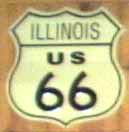
|
Get Your Kicks

|
|
Index
These pages look best at 800x600, or 1024x768; at other resolutions
they can look downright strange.
An Introduction
Some background on a good friend, and faithful servant.
There are some things that we just can't
seem to part with, even when it is agreed, if less than unanimously, that
their time is past. We still romanticize the cowboy, the pioneer, and many
of the rest of the icons produced by the history of our short lived
nation, but their eras have passed, leaving nothing but a few old buildings,
some writings 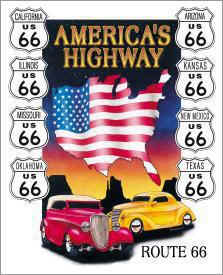 and a great deal of lore and legend. Of course, these intrepid souls did
leave us one other thing. They left us the nation they built, the strongest,
most successful, most free, and most advanced nation in the world. One of
the more recently romanticized figures contributing to the making of our
country is, of all things, a road; it is Route 66. Route 66 tied the country
together in a very real and meaningful way, more so than anything since the
railroads had come through, many decades earlier. Formed in 1927, by a combination
of new construction, and the linking of older roads, it's time was publicly
declared past in 1960, though the last stretch was not officially bypassed
until 1985. In it's passing it has left behind it's own share of legend,
lore and chronicle, but it has left more. There are the small towns, and
villages, the rest stops, museums, points of interest, ghost towns, and tourist
traps. All of these remain along with a uniquely American style and love
of the road trip.
and a great deal of lore and legend. Of course, these intrepid souls did
leave us one other thing. They left us the nation they built, the strongest,
most successful, most free, and most advanced nation in the world. One of
the more recently romanticized figures contributing to the making of our
country is, of all things, a road; it is Route 66. Route 66 tied the country
together in a very real and meaningful way, more so than anything since the
railroads had come through, many decades earlier. Formed in 1927, by a combination
of new construction, and the linking of older roads, it's time was publicly
declared past in 1960, though the last stretch was not officially bypassed
until 1985. In it's passing it has left behind it's own share of legend,
lore and chronicle, but it has left more. There are the small towns, and
villages, the rest stops, museums, points of interest, ghost towns, and tourist
traps. All of these remain along with a uniquely American style and love
of the road trip.
Then there is the pavement itself, thousands of miles
of it. No longer a continuos stretch of highway as in it's glory days, but
broken into a collection of service roads, access points, frontage roads,
and state highways. In some places the pavement remains but has been abandoned
altogether. The end of Route 66 did not so much result in it's destruction;
instead, the road was discarded, with some parts being salvaged, and put
to other uses. The old pavement is nothing like the modern Interstate. The
remains of the old road consist of your basic two lane blacktop, with a yellow
line down the center to separate eastbound from westbound traffic. There
is no limited access here, and any road which crosses the old road produces
an intersection. Businesses built alongside the road are easily accessed
by driveways, pull outs, and service roads, just as on a city street. In
many ways, this is just what the old road was, a 2400 mile long city street,
the Main Street of America.
The old road has left more than legend, and more than
physical structure; it has changed us. It has instilled within us, the culture
of the road, the automobile, travel, and freedom. Truck stops got their start
here, along with motor courts, motels, road houses, drive ins, and a variety
of tourist traps. The oases, dear to travelers everywhere, was an innovation
of Route 66. The boredom of long road travel gave rise to a selection of
museums, gardens, zoos, and "educational" exhibits. Many new things were
tried here; some failed, some succeeded.
Route 66, and some other roads like it, prepared the
nation for the age of the automobile. It introduced us to the idea of the
motor tour, and weaned us from the old dirt tracks, trails, and named roads
carried over from horse and buggy days. These new roads had a far greater
role in renewing the sense of adventure and love of travel which so marks
our culture, than anything done by Ford, Chevrolet, or any of the other automobile
manufacturers. They also gave entrepreneurs, as well as big business
a taste of what services they would likely find a market for as America grew
more mobile. These roads then, were a learning tool, as well as a means of
getting across the country. The lessons learned on the old federal highway
system were not forgotten when the Interstate was being designed. Unfortunately,
a whole new series of lessons would need to be learned once the Interstate
was put into large scale use. The more studied approach of the Interstate
gave us broad straight ribbons of unbroken pavement, removing much of the
excitement, if not the terror, of traveling the old road.
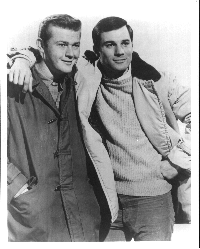 How do you wax poetic about a road? Well, if the road
in question is Route 66, it is quite easy. How many Interstate highways have
songs written about them, or television series based upon them? What other
road has legions of travelers from all over the world, coming just to plant
their tires, and their feet upon it's pavement? The Route 66 television series
was less about the road, and more about what you might find traveling on
it. The same holds true about the song, and the legions of stories, movies,
and books about the old road. The television series sparked an interest in
the road in a new generation, even as The Grapes of Wrath had inspired the
generation before. A series of road movies, and a nostalgia craze for the
fifties, generated the same interest in yet another generation. Even after
over seventy years, and nearly twenty years past the time it was officially
closed, people continue to discover new things along it's length.
How do you wax poetic about a road? Well, if the road
in question is Route 66, it is quite easy. How many Interstate highways have
songs written about them, or television series based upon them? What other
road has legions of travelers from all over the world, coming just to plant
their tires, and their feet upon it's pavement? The Route 66 television series
was less about the road, and more about what you might find traveling on
it. The same holds true about the song, and the legions of stories, movies,
and books about the old road. The television series sparked an interest in
the road in a new generation, even as The Grapes of Wrath had inspired the
generation before. A series of road movies, and a nostalgia craze for the
fifties, generated the same interest in yet another generation. Even after
over seventy years, and nearly twenty years past the time it was officially
closed, people continue to discover new things along it's length.
This road carried the commerce of a nation. In many
ways it was a victim of it's own success. Stretches of the road were known
for the number of fatalities they produced; legendary names like "Dead Man's
Curve", were a reality out on some parts of "bloody 66." The existence of
the road, a link from, the heart of the country out to it's western edge,
encouraged people to travel, increasing traffic to levels not envisioned
by the original planners, and builders. Ironically, in recent times, the
Interstate which replaced sections of the old road has found itself the victim
of the same type of success.
A few facts about the road, along with some comparisons
America's main street was one road in name only, at
least in the beginning. What was to become Route 66 started out as a collection
of county roads, state highways, and assorted trails (paved and unpaved).
These were chosen by a committee, to be integrated into what would become
the main road between the midwest, and the Pacific coast. Initially, the
only thing unifying this collection was a series of road signs, and a designation
on a map. Even so, this was a pretty ambitious undertaking, for 1927.
A look at the map gives some idea as to the extent of
the road, but does not give a clear idea of the range of climate and terrain
it traverses. The map is flat, not showing mountains, deserts, woodlands,
rivers, prairies, and the numerous other obstacles which plagued the first
adventurers to attempt crossing the continent, a century earlier. Thanks
to the pioneering efforts of roads like Route 66, and the follow up of the
Interstate system, we have come to take such ease of travel quite for granted.
In any other part of the world, a trip of such a length, over such a varied
terrain, would be a challenge at best, probably an adventure of a lifetime,
and life threatening at worst. Here, it is just a matter of hopping in the
car and bringing enough money (or the credit cards) to pay our way. To put
things in perspective, let's look at how the rest of the world gets around.
In Europe there has never been anything like a transcontinental
road. The closest thing might be the system of railways, and in particular,
the old Orient Express. Although the route varied throughout the years, it
ran from Paris to Istanbul, a distance of 3186 kilometers. This comes out
to something like 1800-1900 miles. Still not quite up to the distance of
Route 66. Counting the spur line which starts at Calais, and adds another
hundred miles or so, brings it within a few hundred miles of the length of
old 66. This takes the traveler across the entire width of Europe, crossing
the alps, a few time zones, and the borders of a number of countries. It
also takes the traveler through eastern Europe, and into Asia. Be sure to
bring your passport, lots of money (in various currencies, unless you wish
to wait in lines to have money changed over in the eastern countries), and
even more patience. The train, once the lap of luxury, has become a test
of endurance, temper, and in some cases courage.
In Russia, I have to admit that, the old road has met
it's match. Once again, we need to look to the railroads to find a contender;
there are no roads in the former Soviet Union to match Route 66. There is,
however, a railroad unique in the world. The Trans-Siberian Railroad is the
longest in the world. It's 6000 mile span reaches a quarter way around the
world (actually closer to a third, at it's latitude). If Route 66 were to
exist in Russia, it would stretch from Moscow, all the way across European
Russia, and over the Ural Mountains, until it ended deep within the desolate
wilds of Asian Russia. If you were to start Route 66 at the base of the Ural
Mountains, it would go through Moscow, pass out of Russia, and end somewhere
in the middle of Poland. Isn't geography fun!?
In asia, there is the Burma road which connected India,
with China, a distance of about about 700 miles, and took four years to build.
Hardly more than a glorified local spur, compared to old 66. Old 66, if built
in India, could completely cross the country, either running north-south,
or east-west. A more interesting comparison can be made by assuming Route
66 is started in Bombay, and heads, north, and then west. Such a road would
pass through Inda, Pakistan, Iran, and parts of Iraq, just about connecting
Bombay with Baghdad. If India 66 were to head east, it could connect Bombay
to Hanoi in Vietnam, or to Chunking, the former capitol of China.
Africa has no serious road, or railroad system, and
has had none since the passing of colonial times. Tribal wars, petty dictators,
poverty, and famine have destroyed much of the old infrastructure of colonial
days, and have seen to it that the population of Africa has had more serious
matters to busy itself with, than the building of roads. Even during colonial,
and pre colonial times, travel within central Africa was extremely slow,
and hazardous. The tsetse fly, host and carrier of sleeping sickness, meant
that there could be no travel by horse south of the desert. No horses meant
no real roads or trails of any size were built. No travel system of any length
was possible until the introduction of the railroad, by the colonial powers.
A road the length of Route 66, if built, would take one completely across
the continent in all but the widest portion. Even here, it would only miss
touching both oceans by a few hundred miles. Going from north to south, African
66 would take the daring traveler from the shores of the Mediterranean sea,
across the deserts of North Africa, and into the heart of the Congo.
As can be seen by the examples above, in any other
part of the world, the building of such a road, not to mention the support
structure, businesses, and stops along the way, would be a major achievement.
Here, the road is relegated to secondary status, and would have been discarded
altogether, were it not for the interest shown by tourists. In America,
this 2400 mile stretch of pavement passes through big cities, small towns,
8 different states, desert, mountain, prairie, woodland, and farmland. It
passes through some of the richest, most productive farm land in the world,
and through some of the most barren and sterile areas on the planet. At certain
times of the year, the road is capable of taking you from freezing cold to
unbearable heat. You can cross rivers swollen to flood stage, and a day or
two latter pass through dry areas where no water flows, and there has been
no rain for months. People talk funny, in some of the places the road takes
you, though you will be too polite to say so. In turn, these people will
be too polite to tell you that, to them, you talk funny too. The road itself
says nothing, merely humming contentedly beneath your tires.
Unlike the modern interstate, which merely connects
the nation, Route 66 actually joined it. It is possible to travel from one
end of the country, to another, via the interstate, without ever driving down
a city street, or actually seeing a city proper. We may drive through cities,
on the interstate, but we never really have to enter them. This kind of travel
was not possible on the old federal highway system, of which Route 66 was
a part. This was the reason for it's popularity, and was also what brought
about it's demise.
The Mother Road
Route 66 followed many of the historical paths of pioneers,
and explorers. The Osage Trail, and the Santa Fe trail are just two of the
many legendary routes which grew from tracks into the wilderness to become
local roads, then state or county highways, and then finally became part
of route 66, as a part of the Federal Highway System. Many parts of the old
road started out as Indian trails, before the coming of the white man. Many
more were used by settlers, wagon trains, and particularly as military roads.
As cars began to dominate as a means of everyday transportation, it became
pretty apparent that, for long distance transportation, the odd patchwork
of roads crawling and twisting through the countryside, sometimes connecting,
sometimes not, were unsuited to our new found mobility.
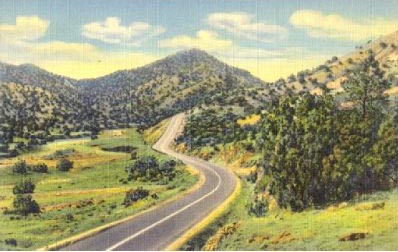 Plans were begun in the early twenties, and by 1927,
the road itself came into being. In many ways these federal roads were the
final end to the old cowboy, pioneer, and trail system, and ushered in the
new era of automobile travel. Their time had come. A combination of production
line manufacturing, and post war prosperity, greatly increased the acceptance,
and number of automobiles in the nation. New technology developed for the
war and applied to peace time products, greatly increased the speed, power
and reliability of the new breed of cars on the road. It was now possible
to own, and operate an automobile without being a mechanic, or an adventurer.
It was also possible to acquire a car without being wealthy. Added to all
of this was the restlessness that always follows the end of a major war.
Young men displaced from society, struggled to find their purpose; but there
was more to the perceived need for these roads, than all of this.
Plans were begun in the early twenties, and by 1927,
the road itself came into being. In many ways these federal roads were the
final end to the old cowboy, pioneer, and trail system, and ushered in the
new era of automobile travel. Their time had come. A combination of production
line manufacturing, and post war prosperity, greatly increased the acceptance,
and number of automobiles in the nation. New technology developed for the
war and applied to peace time products, greatly increased the speed, power
and reliability of the new breed of cars on the road. It was now possible
to own, and operate an automobile without being a mechanic, or an adventurer.
It was also possible to acquire a car without being wealthy. Added to all
of this was the restlessness that always follows the end of a major war.
Young men displaced from society, struggled to find their purpose; but there
was more to the perceived need for these roads, than all of this.
After the First World War, the nation roused itself,
looked around, and seemed to get a sense of itself being something other
than a collection of rogue states, cowboys, farmers, and country cousins
living in the shadow of their European parents. This was when we began to
see ourselves as a great nation, and first realized that we were a world
power. The First World War had been a case of the new world coming to the
aid of the old. Yet, as we began to take ourselves seriously, we began to
note some strange discrepancies. There were parts of this new world power,
that were nearly inaccessible, while many areas seemed scarcely to have changed
since the days of the pioneers.
One gauge by which the cohesiveness of of a civilization,
and the stability of it's culture can be measured, generally has to do with
the speed at which communications, and travel can occur, and the dependability
of the means of accomplishing these. Using this gauge, the United States was
not what you could really call a unified nation, for much of it's existence.
At the time the new roads were being considered, radio was just beginning
to enter it's golden age, and the telephone was just starting to to gain ground
on the telegraph. Long distance phone calls were a bit of a hit and miss
venture. Communication through the mails was erratic, and sometimes undependable,
but was regular; transportation was a different matter.
Even after the first world war, the major mode of long
distance travel was by train. The major routes were those  laid down during the days of the frontier, and the wild west; it seemed that
in some cases, the trains themselves were not much newer. Yet these vintage
corridors were largely what linked the nation, moving it's commerce, keeping
it connected, fed, and supplied. The railroads were one of the first real
monopolies in this country, and travelers were limited to the routes, schedules,
regulations, and limitations imposed by the railroads.
laid down during the days of the frontier, and the wild west; it seemed that
in some cases, the trains themselves were not much newer. Yet these vintage
corridors were largely what linked the nation, moving it's commerce, keeping
it connected, fed, and supplied. The railroads were one of the first real
monopolies in this country, and travelers were limited to the routes, schedules,
regulations, and limitations imposed by the railroads.
There were roads, of course, but these roads were as
old, if not older, than the routes the trains traveled. Many were little
more than trails. The long distance traveler could expect, at the very least,
to become lost. Maps were poor, road markings almost non existent, and services
hit or miss. From the road itself, the traveler could not know what to expect.
There was no consistency. A road could be a mud track, paved dirt, gravel,
stone, or asphalt. Even more important, was the chance that a given road
may or may not have connections to other roads. For the transport of goods,
the roads were not really an option, except for local cartage.
The federal highway system, took us from trails to
superhighways It is sometimes difficult for us to understand just how much
the new roads unified the country, and changed the way we think about travel.
Fifty years before the coming of the federal roads, wagon trains had still
headed out west. The last great land rush took place, in Oklahoma, less
than forty years before. It is ironic that many of those involved in that
final rush would find themselves, or their children, on the road escaping
the devastation of the dust bowl years.
During the 19th century, the various homestead acts
had done a good job of spreading the population, and filling the country.
The challenge now, would be to connect all the little nooks and crannies occupied
by a people who, in the space of half a century, had filled a continent.
Stops along the way
One of the big attractions of "The Main Street of America"
is that, in many ways, this is just what it was. Route 66 did not bypass
cities, or even seek to avoid them; it took us right through the heart of
them. In numerous small towns, and big cities, Route 66 takes one down Main
Street, Central Avenue, or First street. These main thoroughfares were chosen
because, as main streets, they were generally the widest, smoothest, straightest,
and most direct routes through town. Most were already connected to county
or state roads, many having gotten their starts as local roads around which
their towns had grown up.
Actually, this jumping from town to town was not too
different from the way that travelers had traditionally covered long distances.
Back before the federal highways, and before the improvement of the maps,
the long 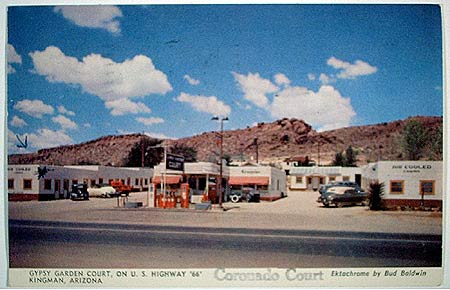 distance traveler would need to go from one city to another, seeking the
road in each town which would lead to the next. In order to keep from dead
ending in the middle of nowhere, the wise traveler would generally plan his
route to lead from one major city to another. So the new federal roads were
laid out to follow the cities which preceded them.
distance traveler would need to go from one city to another, seeking the
road in each town which would lead to the next. In order to keep from dead
ending in the middle of nowhere, the wise traveler would generally plan his
route to lead from one major city to another. So the new federal roads were
laid out to follow the cities which preceded them.
In other cases, the towns grew up along the road, starting
out as collections of businesses geared to serve the needs of the traveler.
Route 66 has been called, a single city with only one street, though that
street is 2400 miles long. It can certainly seem that way, particularly when
passing through the tourist traps, and garish little towns designed to entice
the traveler. The best of these little towns were delightful attractions
in their own right; the worst were little more than speed traps, and places
to get overpriced food, and lodging, both of dubious quality. Of course,
half of the fun and adventure of travel is learning to discern the bad from
the good, seeking out the latter.
Seasoned travelers share their knowledge, and lore
of the road. A common bond of shared experience links them all. Every traveler
on Route 66 has seen the big cross, the blue whale, the tilted water tower,
the Cadillac Ranch, and the various art deco gas stations, along with numerous
trading posts, stands, and assorted roadside stops. So perhaps you stopped
at the trading post of Chief Yellow Horse, and perhaps you did not, but you
did pass it, and see it, as did all of the other travelers on the road. Then
there is dinner at Ollie's in Tulsa, or perhaps at the Dixie Trucker's home
in Illinois. You may have had a custard at Ted Drew's in St. Louis, or tried
the 72 ounce steak at the Big Texan in Amarillo. Not all travelers stopped
at the same places, but all were exposed to the same variety. This gave a
certain similarity of experience, but made each journey, and each traveler's
individual perceptions of the road, just a bit unique.
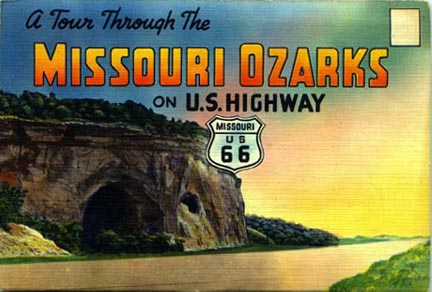 There is more to the old road, however, than places
to eat, or stay, and places to buy trinkets. One of the more interesting,
and hopefully enduring, legacies of the old road comes from all of the cities
and towns stretched out across it's length. Some were never anything more
than little stops to eat and get gas (so to speak), while others were large
cities which long predated the existence of the road. All became part of
it's substance, coloring, and flavoring it with their own unique styles,
even as they were colored and flavored by the road. Regions too, added their
share to the allure of Route 66. The Midwest, the Southwest, California,
and bits of the south, all added to the experience of traveling through the
breadth of America on Route 66.
There is more to the old road, however, than places
to eat, or stay, and places to buy trinkets. One of the more interesting,
and hopefully enduring, legacies of the old road comes from all of the cities
and towns stretched out across it's length. Some were never anything more
than little stops to eat and get gas (so to speak), while others were large
cities which long predated the existence of the road. All became part of
it's substance, coloring, and flavoring it with their own unique styles,
even as they were colored and flavored by the road. Regions too, added their
share to the allure of Route 66. The Midwest, the Southwest, California,
and bits of the south, all added to the experience of traveling through the
breadth of America on Route 66.
Chicago, St. Louis, Oklahoma City, Los Angeles, and
the other big cities along the way, add a welcome bit of civilization to
travel along the road. They are good places to stock up on food, do a bit
of shopping, and perhaps stay in a fine hotel. They do make their own contributions
to the journey, but they are the public face of the old road. Though each
large urban area has it's own local flavor and history, most have been homogenized
somewhat, to the extent that most have the same chain stores, restaurants,
and generic "big city" way of doing things. The private face, and the heart
of the road is contained within the cities, and small towns which grew up
and out of it. These special places are sometimes unique to the point of
being eccentric.
The more out of the way, and the more dependent on
the road, they are, the larger the amount of eccentricity. 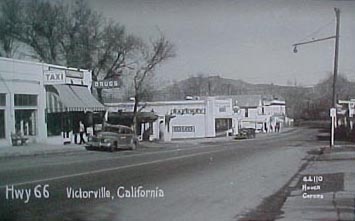 Some of the high desert mining towns in Arizona, are particularly unique.
Hackberry, and Seligman seem like little more than collections of shacks.
Oatman with it's free ranging wild burros, or Kingman, climbing up the side
of a mountain, surrounded by high desert, and twisted roads, seem somehow
otherworldly. In California, the little hamlets of Amboy, Newberry Springs,
and Bagdad seem to define the notion of the little town in the middle of
nowhere. Set in the heat of the desert, amidst dried out lake beds, there
is no earthly reason for these towns to be here. There is no industry, no
hope of agriculture, and no agreeable climate. The only reason these towns
ever came to be, was the presence, and the need to service, the road.
Some of the high desert mining towns in Arizona, are particularly unique.
Hackberry, and Seligman seem like little more than collections of shacks.
Oatman with it's free ranging wild burros, or Kingman, climbing up the side
of a mountain, surrounded by high desert, and twisted roads, seem somehow
otherworldly. In California, the little hamlets of Amboy, Newberry Springs,
and Bagdad seem to define the notion of the little town in the middle of
nowhere. Set in the heat of the desert, amidst dried out lake beds, there
is no earthly reason for these towns to be here. There is no industry, no
hope of agriculture, and no agreeable climate. The only reason these towns
ever came to be, was the presence, and the need to service, the road.
What today strike us as a bunch
of sleepy little towns, were raucous places on the old road. They may become
lively again, as, like so many of the youthful travelers which have passed
through them, they seek to find their place along the road. Winslow, and
Tucumcari in particular, were known as busy, lively places. Williams had,
for years, been the jumping off point for the Grand Canyon. This is an honor
it is seeking to regain, by an extensive series of improvements, and tourist
attractions, including a regular steam train into the park. Then there are
the deserted places like Twin Arrows, Two Guns, Allenreed, and Glen Rio,
or the nearly deserted places like Meteor City (Pop 2). The old road takes
us through all of these places, some familiar, and some unheard of, except
by the  locals.
locals.
It also takes us into the countryside. The language
was carefully chosen here: where the Interstate takes us through the countryside,
the old roads took us into them. Though we have become largely a nation of
cities, and urban dwellers, such was not always the case, and even today is
not entirely the case. Besides a glimpse of our rural culture and heritage,
these country roads also take the traveler through the raw geology, and geography
of the continent. Unlike the Interstate, these older roads, permit pulling
over, getting out, and doing a bit of exploration. There is really much to
explore here. No matter what the climate, or part of the country you come
from, old 66 is guaranteed to take you through the different and the unfamiliar.
Aside from the cities, and the countryside, Route 66
gave the traveler plenty of the new and unfamiliar to explore. The meteor
crater is just off of the road, as are the Petrified Forest, Painted Desert,
and the Grand Canyon. Sandia, where nuclear weapons are developed and built,
stands near the road, along with the Atomic Missile Museum. You can sleep
in a wigwam, or in a room, and a bed, where Elvis once slept. You can also
sit on the back of a statue of a giant jackrabbit (complete with saddle),
and enjoy a nice cool cherry cider in the heat of the Arizona desert. You
may find yourself doing many things that you would never think to do back
home.
Where the modern interstate impairs and inhibits us
from stopping, the old road practically insists upon it. Where the Interstate
seems a bit ashamed of some of the places through which it passes, isolating
us, and hustling us along, the old road welcomes exploration, as if proudly
showing off the places it has collected to itself in it's wanderings.
Defining the era of the American Dream
What is it about old 66 that inspires such devotion,
fanaticism, and even feelings approaching love? Certainly, it is not the pavement
itself; there is no shortage of two lane blacktop roads in the world. It
can not entirely be a love of the cities, and places along the road. Though
some of these locations are quite nice, others are very unpleasant indeed.
Could it be the freedom of the road? Well, perhaps a bit, though the Interstate,
sanitized as it may be, is faster, safer, smoother, and has better services
than the old road ever offered.
Route 66, along with a few other cultural icons, became
a focal point for an idealized America. The fact that it was decommissioned
at about the same time that many had given up, or lost their faith in the
old ideals, left it permanently associated with them. When, in latter years,
we discovered that we missed much of what we had discarded, it was natural
for us to search for these things in the places they had last been seen. Some
other expressions of freedom, confidence, and optimism, related to our love
of the road are:
- Drive in movie theaters
- Drive in (not drive through, an invention of the interstate) restaurants.
- Muscle cars
- Service stations (and they meant it).
- The family vacation
- National (and state) parks
- Little towns
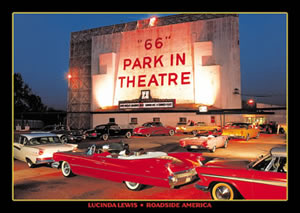 There is a sort of a combination of quaintness, excess,
wholesomeness, and self indulgence that we associate with the bygone days
of the old American Dream. Certainly many other versions of the American
Dream have risen, but there is something special about the post war boom,
optimism, power, and sense of purpose that is longed for, even by those who
helped bring about it's demise. The social activism, sexual revolution, new
politics, and self awareness of the sixties, and seventies toppled much of
the aura of old America. Though few people miss the racism, quiet hypocrisy,
and mild paranoia of those days, our "progress" has not come without a price.
In curing, or trying to cure many of our former social ills, we have unwittingly
discarded much that was of real value to us. It seems like a case of "the
operation was a success but the patient died." The old evils have been replaced
by a set of new ones, less apparent, more complex, and more difficult to
deal with. They have been replaced by the hypocrisy of political correctness,
a distrust of our own government, loss of faith, loss of confidence, and loss
of belief in our own culture and morals.
There is a sort of a combination of quaintness, excess,
wholesomeness, and self indulgence that we associate with the bygone days
of the old American Dream. Certainly many other versions of the American
Dream have risen, but there is something special about the post war boom,
optimism, power, and sense of purpose that is longed for, even by those who
helped bring about it's demise. The social activism, sexual revolution, new
politics, and self awareness of the sixties, and seventies toppled much of
the aura of old America. Though few people miss the racism, quiet hypocrisy,
and mild paranoia of those days, our "progress" has not come without a price.
In curing, or trying to cure many of our former social ills, we have unwittingly
discarded much that was of real value to us. It seems like a case of "the
operation was a success but the patient died." The old evils have been replaced
by a set of new ones, less apparent, more complex, and more difficult to
deal with. They have been replaced by the hypocrisy of political correctness,
a distrust of our own government, loss of faith, loss of confidence, and loss
of belief in our own culture and morals.
In the fifties, and into the sixties we knew we were
the wealthiest, most powerful, and advanced country in the world. More important
though, we knew we were the moral, and cultural superior of every other nation
on Earth. We knew we were right. As much as we today worship the self, independence,
choice, and individuality, we long for the stable family with mom at home,
dad at work, junior and sis at school, and the certainty that tomorrow would
be better than today. What we also long for, despite our new worship of "open
mindedness" is the certainty that we are right, that we are on the right
track, fighting the good fight, and making the world safe for democracy,
that we can trust our leaders, our neighbors, and ourselves to do the right
thing.
That sense of identity, security, correctness, and
purpose is what we so long for, when we go searching for the old 66, and
the nation it served. What is surprising is that, in many places, it is still
there. In traveling the old road, I have seen small towns and big cities
in the process of rebuilding themselves. This was particularly apparent in
places like Oklahoma City, and Tulsa. Then there is the stubborn pride of
places which have seen better days, but cling proudly to their old identities
as they seek to make a comeback, places like Tucumcari, NM. Galena, KS. and
Williams AZ. There are also the timeless places, which seem unaffected by
the road, or by much of anything else. Some are large cities, like Chicago,
and Los Angeles themselves, while others are a bit more modest, places like
Flagstaff, or St. Louis. These were all great cities, filled with a great
people. Some remain so, while others struggle on.
So we travel the old road, buy the souvenirs, listen
to the old music, and make a fad out of "retro" fashions, dances, cars, and
furniture. We also keep a close watch for Elvis.
Passage into legend
The new system of Interstate Highways, spelled the
end of the old Federal Highway System. From 1960, when it's end was pronounced,
to 1985 when the last section was bypassed, and it's traffic routed to the
Interstate, Route 66 began to die the slow death of 1000 cuts. About the
time that the road was being phased out, it began to attract it's greatest
following. When Route 66 first aired as a television show, sections of the
road had already been bypassed. The vast majority of the road was still there,
but the writing was on the wall; the end was clearly near. Many people desired
to travel the legendary road just once (or just once more) while it could
still be done.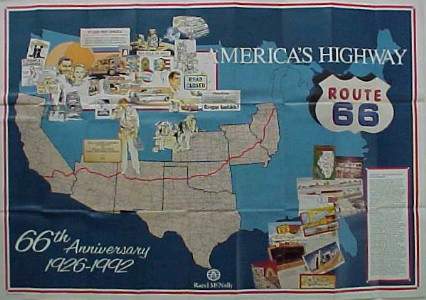
The road did not die easy. Almost everywhere the Interstate
came to replace it, objections were lodged, injunctions were sought, and
protests were organized. This was done, in many areas, for sentimental reasons,
but in many others the reasons were dead serious. The passing away of the
road was the death knell for many of the small towns, and hamlets which got
their living from it. It was also the death knell for many roadside businesses,
which would be inaccessible, or nearly so, from the limited access Interstate
which was to replace the old open access road.
Throughout the sixties, most of the road remained, and
it was still the preferred route across the country, but in the seventies,
the old road was noticeably truncated, broken up, and difficult to use as
a continuos highway. Road signs and markers were removed from city streets,
and rural highways, making the old road hard to find, and difficult to follow.
It was no longer clearly marked on maps. By the time the last stretch was
closed in 1985, only a few purists, or old timers, even knew how to find
the old road. Really by this time the road was already long dead. The final
stretch was kept open in Arizona by a series of legal maneuvers, but it's
closure was inevitable.
Most people paid little mind to the replacement of
the old road. This was progress, after all, and you can't stand in the way
of something so sacred. So the little towns died, or grew much smaller, the
old roadside businesses withered and faded to disappear, and the traditional
stopping off points were passed by. A few things began to strike travelers
about the new Interstate system, though. Traveling on it was deadly dull,
consisting of long unbroken stretches of concrete. Where was the romance of
travel?
The Interstate
It may seem that I have cast the Interstate in the
role of the villain in this story. In truth, I love the Interstate,
and travel it often. The Interstate is a great way to get around, within
it's limitations. These limitations are:
- You can't pull over, and can not easily get off. You are confined
to the road, except at the ramps.
- You can't get to anything, except by taking the nearest ramp and
then backtracking. Even this only works if there happens to be an access
or frontage road running alongside the Interstate; in many places there is
not.
- Land is expensive at exits. No longer can a little guy start a
small business, on the road, it is now all big sanitized chains.
- The Interstate bypasses the cities, and small towns along the way.
Of course, the Interstate is not without it's advantages. These are:
- The Interstate is fast.
- It is much less likely you will become lost.
- With some exceptions, the Interstate is much safer.
The Interstate has also done some harm to our culture,
and particularly to many of our larger cities. Those of us in our forties,
and older, may still remember the days when the new construction cut a swath
right down the center of town, removing the heart from many cities. Houses
were knocked down, businesses relocated, or shut down, and hundred year old
neighborhoods razed or at the very least partitioned. There were always rumors
circulating, or jokes being told about families barricading themselves in
their houses, and refusing to leave, or homeowners lying down in the path
of bulldozers. Most left, disgruntled, but without causing trouble, to settle
in new places.
Where the old road had taken traffic through city streets,
via a marked route, the new Interstate made no concessions, and seemed to
take little notice of the cities through which it was built. It became a
world of it's own, replacing rather than merging with the places through
which it traveled. Once the new superhighways were finished, the construction
crews would move on, and the city which had happened to be in the way, was
left to heal it's wounds as best it could. Many never quite healed right,
and even those that did were left somewhat disfigured. There was the physical
destruction of the parts of the city that the road went through, but there
was also the strange way that most cities had of adapting to the presence
of the new Interstates.
One of the first things that the presence of the freeways
did was to turn many of the downtown areas, and other business districts
into little more than staging areas for the freeway on ramps. In many places,
main roads, and side streets were made one way, or rerouted, to more efficiently
direct traffic onto the new freeways. Old photographs taken of the downtown
areas of most major cities will show streets lined with parked cars, sidewalks
filled with pedestrians, and a selection of busses, and streetcars. A contemporary
photograph of many of the same places will show only stalled traffic. Street
parking was eliminated so that new traffic lanes could be added to help handle
the load. This tended to make many downtown areas places to pass through,
rather than places to stop, but worse was to come.
As city business districts became less amenable to
casual wandering, People began to frequent them less often, and for shorter
periods of time. This had the predictable effect of stagnating much of the
traditional downtown commerce, and forcing the businesses depending upon
consumer traffic, to move out or go under. Over time, things became much
shoddier, and of smaller scale. Downtown areas became a bit disreputable,
and run down. This added further to their abandonment. So where could people
now go to shop?
The newly built shopping malls, out in the newly accessible
countryside, could provide for all of the shopping needs of the most voracious
consumer. Soon enough, even those who remained in the city, came out to the
malls. After all, they were so new, and so clean, not like the torn up downtown
areas of the city itself; also unlike the downtown areas, out in the malls,
you could actually park your car, and stay a while. They were also, relatively
safe. The downtown, and central areas of the city had started to become very
unsavory places, or at any rate, they had become places in which a certain
amount of caution need be shown.
What of the main streets through town, the ones which
people had traveled every day to get to work, or to shop? Well, most of these
city sections were bypassed, by the new freeways, and left to whither on
the vine. Most people took the freeway through town, rather than the city
streets, in order to avoid lights, and to make use of the faster freeway
speeds. This was a sort of a minor version of the disasters which befell
the towns being bypassed by the Interstate. This also had the effect of segregating
older parts of town, which had only been busy in the first place, because
they were the major routes through the city. Once alternate, and faster,
routes became available, there was little incentive to travel through certain
areas of town, making them isolated backwaters.
I used the word "segregating", to describe the cutting
off and containment caused by many of the new freeways; this word was not
completely chosen at random. Though there had always been racial segregation
in the country, the new freeways, by permitting the isolation of large sections
of the inner and central city, made the process much more complete. So just
as the civil rights movement was beginning to make some changes in attitudes,
and in law, the new fragmenting of the city helped to enhance the segregation
of the races. This point was emphasized by a footnote in one of the current
guidebooks to Route 66. It warns the reader about following the old road
through certain parts of the Chicago, and St. Louis areas, recommending that
the wary traveler bypass these places, and take the Interstate through town.
Had Route 66 remained the main corridor, and had the Interstate not cut off
these sections of town, they would not (could not) have been allowed to fall
to such a state. Since these neighborhoods became bypassed, and were no longer
"important" to the city at large, they were allowed to decay, and to become
dangerous. Rather than pulling together, insisting that these areas be fixed,
or fixing them directly, most of the middle class simply moved away from
them, escaping rather than repairing, the damage.
While construction of the new freeways was engaged in
tearing up the heart of the city, and fragmenting it, the freeways themselves
made the city easier to get out of. Once upon a time, you needed to live in
town to be close to work, schools, shops, and cultural activities, but not
any more. Now, a short drive on the Interstate could get you out in the country.
Little farming communities, and small towns out in rural areas, suddenly
became popular places for the newly mobile to live. This was probably the
worse effect it had on the cities, since it was now possible to simply ignore,
abandon, or discard them, in the minds of those who could move out. Twenty
years before, problems of crime, poverty, decay, and corruption, would have
had to have been dealt with; the coming of the freeways, made it possible
to simply move away from them. So cities became disposable, and large sections
of them were, in effect, disposed of.
With all of this moving out, commuting, and bypassing,
cities (now called urban areas to reflect the dependencies of the suburbs,
and satellite cities) became much more spread out. This made cars a necessity,
for even the most mundane things. It also made possible the large megamarket,
and mega store, effectively squeezing out the small shopkeeper. Suddenly,
everything became much more impersonal, farther away, and less intimate. The
idea of a functioning neighborhood went away. People began to shop, work,
and go to school, miles from the places where they happened to live.
On the other hand, the Interstate can get me anywhere
in the country within a few days. The urban sprawl it has fueled is good
or bad, as a matter of personal taste. I personally hate it, and hate the
blight it has contributed to in the cities. Having said this, I must admit
that I personally live in a far western suburb of Milwaukee, though I would
have probably stayed in the city had urban sprawl not so decimated the downtown,
raised the taxes, and siphoned off so many of the jobs, and culture of the
Milwaukee I had known as I was growing up.
Route 66 Today
So what has become of this famous, and beloved road? Well,
a number of things, depending upon which stretch of road you are talking about.
It seems as if the old mother road has gone back to it's roots, becoming
once again, a broken series of sometimes connected, but unrelated stretches
of pavement. In general, you will find the physical remnants of the old road
as one of the following:
- Frontage roads
- Business roads
- Paved over and integrated into the Interstate.
- Abandoned local dead end stretches
- Scenic, restored stretches
The most common use to which the pavement of old 66
is put, is as frontage roads, serving the Interstate which replaced it, and
providing local access for the people in the area, and the occasional tourist.
In many places the old road will veer away from the Interstate, and take
the traveler off the beaten path a bit. Some of these isolated areas are
treasures of lore, history, and local color; others are depressing bits of
abandoned America, left to ruin. In many other places, particularly in the
southwestern states the old road will run right alongside the Interstate for
miles. In many of these areas, it is nearly impossible to travel the old
road for any distance. The service roads, into which it has been transformed,
tend to be broken up at intervals by ramps, crossings, or even by the occasional
intrusion of the interstate onto the former roadbed of 66.
In medium to large cities, or areas of special interest,
the old road will become a business bypass. In most of these places it will
be called Business 40. The business roads, tend to go through either the
middle of town, or through special business districts on the outskirts. Often
they will do both, taking the traveler through busy areas full of shops,
malls, motels, and restaurants, before passing through the heart of the city.
These business loops can be a great deal of fun, particularly since the renaissance
and rediscovery of old 66. They are probably closer to the feel, pulse, and
old liveliness of the original 66, than any other place, including the restored
scenic sections.
In a few areas, 66 has been completely abandoned. There
is one long stretch like this, where the road crosses from Texas into New
Mexico. In this spot, the road has been abandoned because the Interstate
takes a shortcut. The road is still there, and it can be accessed by getting
directions from the locals. It starts out as a city street, which heads out
of town, and disappears into the desert/prarie. It is not closed off, nor
is it forbidden for travelers to embark upon it. This stretch has been abandoned
in the sense that it is no longer shown on maps, road crews no longer maintain
it, and there are no services along it's length, but it is still there. The
Texas/New Mexico border stretch is unusual, on most of these abandoned stretches,
the road has simply been cut off at both ends, by freeway ramps. Though these
sections are generally visible from the Interstate, and tend to run right
alongside it, they can be very difficult to access.
In recent years, people have been taking a careful measure
of the culture we have built for ourselves, and have found it wanting, in
many respects. In answer to the nostalgia created by this revisiting of the
past, many areas of old 66 are being restored, marked on special maps, and
are even seeing a return of the old style highway signs. The best section
of this type is probably the small section in Kansas, though there are significant
restored sections in Oklahoma, New Mexico, and Arizona. The midwest seems
to be the last section to revalue the old road, though Illinois, and Missouri
have developed some strong local groups. California, at the west end of the
road, is the state which practices veneration of the automobile, and of the
road more than any other. It has a number of organizations, museums, and
quirky little stops offs on the stretch of old 66 which passes through the
desert.
A New Life
Route 66, and many of the businesses found
on or near it, survive today on tourism. Rather than being a place to pass
through, Route 66 has become a place to be; everyone wants to travel the
old road. On my own travels I have seen individuals, and tour groups from
all over the world. A band of Austrian Motorcyclists pretty much paralleled
my own trip down the old road. I ran into them at Meteor Crater, the Petrified
Forest, and Painted Dessert, the Museum in Galena, and at the Continental
Divide.
All along the old route, the road is reawakening, though
in quite a different form. In the old days, this had been a working road,
but not anymore. Interstate 40 handles most of the commerce, travel, and
day to day business that once depended on old 66. Instead of trucks, salesmen,
relocating families, and business travelers, old 66 now gets tourists, travel
buffs, adventurers, and those nostalgic for the dreams of the past. The road
has become like one of those old steam trains that people pay to ride, or
rather like booking a passage on a cruise line. Many people seek it out to
travel it more for the journey than as a means to get to a destination.
This new lease on life, is by no means a resurrection
of the 66 that used to be. Rather, it is a phoenix risen from the ashes of
what was once a much different and larger animal. The reborn road is busy
enough to keep the little towns, and many of the small businesses along it's
path alive, but will never again have the volume with which to restore them
to their former glory. They will remain icons frozen in time, like the old
cowboy towns which thrive on what they once were. Legendary places from a
time when you could put the top down on your souped up car, throw a few things
in the back, crank the radio, and hit the road to get your kicks on Route
66.






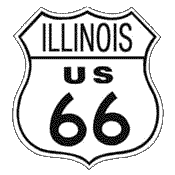
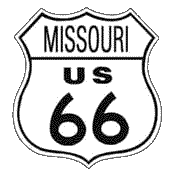
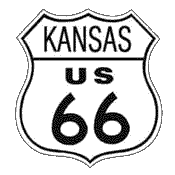
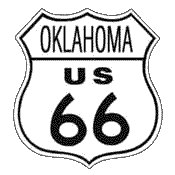
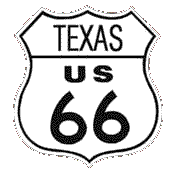
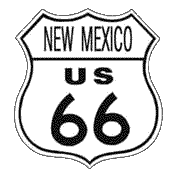
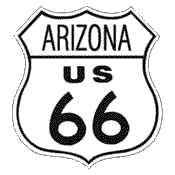
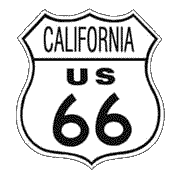
 and a great deal of lore and legend. Of course, these intrepid souls did
leave us one other thing. They left us the nation they built, the strongest,
most successful, most free, and most advanced nation in the world. One of
the more recently romanticized figures contributing to the making of our
country is, of all things, a road; it is Route 66. Route 66 tied the country
together in a very real and meaningful way, more so than anything since the
railroads had come through, many decades earlier. Formed in 1927, by a combination
of new construction, and the linking of older roads, it's time was publicly
declared past in 1960, though the last stretch was not officially bypassed
until 1985. In it's passing it has left behind it's own share of legend,
lore and chronicle, but it has left more. There are the small towns, and
villages, the rest stops, museums, points of interest, ghost towns, and tourist
traps. All of these remain along with a uniquely American style and love
of the road trip.
and a great deal of lore and legend. Of course, these intrepid souls did
leave us one other thing. They left us the nation they built, the strongest,
most successful, most free, and most advanced nation in the world. One of
the more recently romanticized figures contributing to the making of our
country is, of all things, a road; it is Route 66. Route 66 tied the country
together in a very real and meaningful way, more so than anything since the
railroads had come through, many decades earlier. Formed in 1927, by a combination
of new construction, and the linking of older roads, it's time was publicly
declared past in 1960, though the last stretch was not officially bypassed
until 1985. In it's passing it has left behind it's own share of legend,
lore and chronicle, but it has left more. There are the small towns, and
villages, the rest stops, museums, points of interest, ghost towns, and tourist
traps. All of these remain along with a uniquely American style and love
of the road trip.  How do you wax poetic about a road? Well, if the road
in question is Route 66, it is quite easy. How many Interstate highways have
songs written about them, or television series based upon them? What other
road has legions of travelers from all over the world, coming just to plant
their tires, and their feet upon it's pavement? The Route 66 television series
was less about the road, and more about what you might find traveling on
it. The same holds true about the song, and the legions of stories, movies,
and books about the old road. The television series sparked an interest in
the road in a new generation, even as The Grapes of Wrath had inspired the
generation before. A series of road movies, and a nostalgia craze for the
fifties, generated the same interest in yet another generation. Even after
over seventy years, and nearly twenty years past the time it was officially
closed, people continue to discover new things along it's length.
How do you wax poetic about a road? Well, if the road
in question is Route 66, it is quite easy. How many Interstate highways have
songs written about them, or television series based upon them? What other
road has legions of travelers from all over the world, coming just to plant
their tires, and their feet upon it's pavement? The Route 66 television series
was less about the road, and more about what you might find traveling on
it. The same holds true about the song, and the legions of stories, movies,
and books about the old road. The television series sparked an interest in
the road in a new generation, even as The Grapes of Wrath had inspired the
generation before. A series of road movies, and a nostalgia craze for the
fifties, generated the same interest in yet another generation. Even after
over seventy years, and nearly twenty years past the time it was officially
closed, people continue to discover new things along it's length.  Plans were begun in the early twenties, and by 1927,
the road itself came into being. In many ways these federal roads were the
final end to the old cowboy, pioneer, and trail system, and ushered in the
new era of automobile travel. Their time had come. A combination of production
line manufacturing, and post war prosperity, greatly increased the acceptance,
and number of automobiles in the nation. New technology developed for the
war and applied to peace time products, greatly increased the speed, power
and reliability of the new breed of cars on the road. It was now possible
to own, and operate an automobile without being a mechanic, or an adventurer.
It was also possible to acquire a car without being wealthy. Added to all
of this was the restlessness that always follows the end of a major war.
Young men displaced from society, struggled to find their purpose; but there
was more to the perceived need for these roads, than all of this.
Plans were begun in the early twenties, and by 1927,
the road itself came into being. In many ways these federal roads were the
final end to the old cowboy, pioneer, and trail system, and ushered in the
new era of automobile travel. Their time had come. A combination of production
line manufacturing, and post war prosperity, greatly increased the acceptance,
and number of automobiles in the nation. New technology developed for the
war and applied to peace time products, greatly increased the speed, power
and reliability of the new breed of cars on the road. It was now possible
to own, and operate an automobile without being a mechanic, or an adventurer.
It was also possible to acquire a car without being wealthy. Added to all
of this was the restlessness that always follows the end of a major war.
Young men displaced from society, struggled to find their purpose; but there
was more to the perceived need for these roads, than all of this.  laid down during the days of the frontier, and the wild west; it seemed that
in some cases, the trains themselves were not much newer. Yet these vintage
corridors were largely what linked the nation, moving it's commerce, keeping
it connected, fed, and supplied. The railroads were one of the first real
monopolies in this country, and travelers were limited to the routes, schedules,
regulations, and limitations imposed by the railroads.
laid down during the days of the frontier, and the wild west; it seemed that
in some cases, the trains themselves were not much newer. Yet these vintage
corridors were largely what linked the nation, moving it's commerce, keeping
it connected, fed, and supplied. The railroads were one of the first real
monopolies in this country, and travelers were limited to the routes, schedules,
regulations, and limitations imposed by the railroads.  distance traveler would need to go from one city to another, seeking the
road in each town which would lead to the next. In order to keep from dead
ending in the middle of nowhere, the wise traveler would generally plan his
route to lead from one major city to another. So the new federal roads were
laid out to follow the cities which preceded them.
distance traveler would need to go from one city to another, seeking the
road in each town which would lead to the next. In order to keep from dead
ending in the middle of nowhere, the wise traveler would generally plan his
route to lead from one major city to another. So the new federal roads were
laid out to follow the cities which preceded them.  There is more to the old road, however, than places
to eat, or stay, and places to buy trinkets. One of the more interesting,
and hopefully enduring, legacies of the old road comes from all of the cities
and towns stretched out across it's length. Some were never anything more
than little stops to eat and get gas (so to speak), while others were large
cities which long predated the existence of the road. All became part of
it's substance, coloring, and flavoring it with their own unique styles,
even as they were colored and flavored by the road. Regions too, added their
share to the allure of Route 66. The Midwest, the Southwest, California,
and bits of the south, all added to the experience of traveling through the
breadth of America on Route 66.
There is more to the old road, however, than places
to eat, or stay, and places to buy trinkets. One of the more interesting,
and hopefully enduring, legacies of the old road comes from all of the cities
and towns stretched out across it's length. Some were never anything more
than little stops to eat and get gas (so to speak), while others were large
cities which long predated the existence of the road. All became part of
it's substance, coloring, and flavoring it with their own unique styles,
even as they were colored and flavored by the road. Regions too, added their
share to the allure of Route 66. The Midwest, the Southwest, California,
and bits of the south, all added to the experience of traveling through the
breadth of America on Route 66.  Some of the high desert mining towns in Arizona, are particularly unique.
Hackberry, and Seligman seem like little more than collections of shacks.
Oatman with it's free ranging wild burros, or Kingman, climbing up the side
of a mountain, surrounded by high desert, and twisted roads, seem somehow
otherworldly. In California, the little hamlets of Amboy, Newberry Springs,
and Bagdad seem to define the notion of the little town in the middle of
nowhere. Set in the heat of the desert, amidst dried out lake beds, there
is no earthly reason for these towns to be here. There is no industry, no
hope of agriculture, and no agreeable climate. The only reason these towns
ever came to be, was the presence, and the need to service, the road.
Some of the high desert mining towns in Arizona, are particularly unique.
Hackberry, and Seligman seem like little more than collections of shacks.
Oatman with it's free ranging wild burros, or Kingman, climbing up the side
of a mountain, surrounded by high desert, and twisted roads, seem somehow
otherworldly. In California, the little hamlets of Amboy, Newberry Springs,
and Bagdad seem to define the notion of the little town in the middle of
nowhere. Set in the heat of the desert, amidst dried out lake beds, there
is no earthly reason for these towns to be here. There is no industry, no
hope of agriculture, and no agreeable climate. The only reason these towns
ever came to be, was the presence, and the need to service, the road.
 locals.
locals.  There is a sort of a combination of quaintness, excess,
wholesomeness, and self indulgence that we associate with the bygone days
of the old American Dream. Certainly many other versions of the American
Dream have risen, but there is something special about the post war boom,
optimism, power, and sense of purpose that is longed for, even by those who
helped bring about it's demise. The social activism, sexual revolution, new
politics, and self awareness of the sixties, and seventies toppled much of
the aura of old America. Though few people miss the racism, quiet hypocrisy,
and mild paranoia of those days, our "progress" has not come without a price.
In curing, or trying to cure many of our former social ills, we have unwittingly
discarded much that was of real value to us. It seems like a case of "the
operation was a success but the patient died." The old evils have been replaced
by a set of new ones, less apparent, more complex, and more difficult to
deal with. They have been replaced by the hypocrisy of political correctness,
a distrust of our own government, loss of faith, loss of confidence, and loss
of belief in our own culture and morals.
There is a sort of a combination of quaintness, excess,
wholesomeness, and self indulgence that we associate with the bygone days
of the old American Dream. Certainly many other versions of the American
Dream have risen, but there is something special about the post war boom,
optimism, power, and sense of purpose that is longed for, even by those who
helped bring about it's demise. The social activism, sexual revolution, new
politics, and self awareness of the sixties, and seventies toppled much of
the aura of old America. Though few people miss the racism, quiet hypocrisy,
and mild paranoia of those days, our "progress" has not come without a price.
In curing, or trying to cure many of our former social ills, we have unwittingly
discarded much that was of real value to us. It seems like a case of "the
operation was a success but the patient died." The old evils have been replaced
by a set of new ones, less apparent, more complex, and more difficult to
deal with. They have been replaced by the hypocrisy of political correctness,
a distrust of our own government, loss of faith, loss of confidence, and loss
of belief in our own culture and morals. 